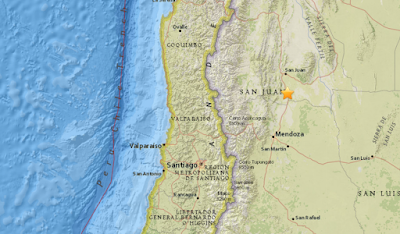The United States Geological Survey
recorded a Magnitude 4.7 Earthquake at a depth of 122.6 km in San Juan
Province, Argentina, slightly before 11.15 am local time (slightly before 2.15 pm GMT) on Tuesday 6 March 2018. There are no reports of any damage or
injuries relating to this event, and nor would any be expected from an Earthquake of this magnitude at this depth but people have reported feeling it in the city of San Juan.
The approximate location of the 6 March 2018 San Juan Earthquake. USGS.
San Juan Province is located on the eastern margin of the Andes
Mountains, one of the most tectonically active mountain ranges in the
world, and the plains to the east of these mountains. The Andes are
being formed as the Nazca Plate to the west is subducted beneath the
South American Plate. This causes quakes in a number of ways. Firstly
there is friction between the two plates as the Nazca Plate passes under
South America. Then there is crumpling and upthrust of the South
American as it is pushed from the west by the Nazca Plate and from the
east by the expansion of the Atlantic. Finally there is volcanic
activity in the Andes, as lighter minerals in the Nazca Plate are melted
by the heat of the Earth's interior, then rise up through the overlying
South American Plate to form volcanoes.
The subduction of the Nazca Plate beneath the South American Plate, and how it causes Earthquakes and volcanoes. Pacific Earthquake Engineering Research Center.
This means that Earthquakes, even large events, are quite common in the
area, but since the province is on the eastern margin of the Andes, such
quakes usually happen at considerable depth (the margin between the
Nazca and South American plates is angled downwards, so that maximum
seismic activity happens close to the surface on the coast of Chile and
deep within the Earth beneath eastern Argentina), so that much of the
energy from the quake is dissipated before it reaches the surface.
Witness
accounts of Earthquakes can help geologists to understand these events,
and the structures that cause them. The international non-profit
organisation Earthquake Report is interested in hearing from people who may have felt this event; if you felt this quake then you can report it to Earthquake Report here.
See also...
Follow Sciency Thoughts on Facebook.








